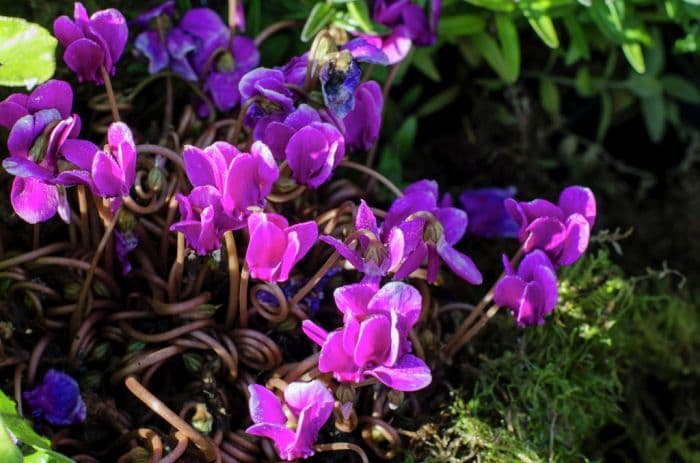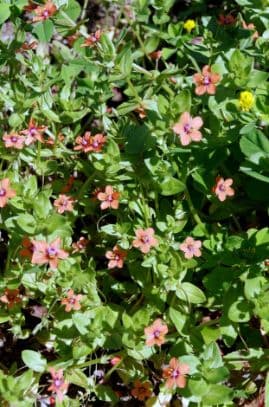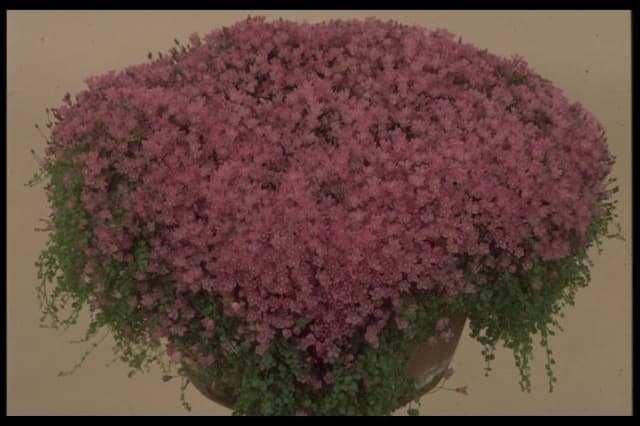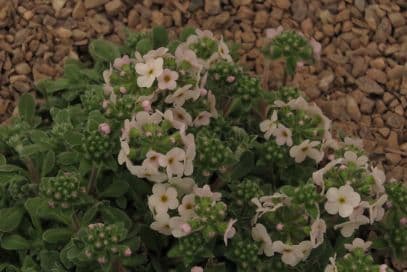Ivy-leaved cyclamen Cyclamen hederifolium 'Red Sky'

ABOUT
Cyclamen hederifolium 'Red Sky', commonly known as the ivy-leaved cyclamen, is distinguished by its attractive foliage and vibrant flowers. This elegant cultivar showcases heart-shaped leaves that are marbled with various shades of green and silver, creating a distinctive and decorative pattern reminiscent of ivy leaves. The flowers are particularly striking, presenting a bold, deep red hue that stands out against the lighter foliage. Each flower has an inverted silhouette, with petals that sweep upwards and gracefully curl at the tips, giving the appearance of a group of small, flying birds when viewed en masse. The ivy-leaved cyclamen blooms typically herald the late summer to autumn period, bringing dashes of color to the garden as many other plants begin to fade. The plant's overall demeanor is one of delicate beauty, underscored by the contrast between the dark red flowers and the variegated foliage.
About this plant
 Names
NamesFamily
Primulaceae
Synonyms
Ivy-leaved Cyclamen, Sowbread, Hardy Cyclamen, Eastern Cyclamen, Neapolitan Cyclamen
Common names
Cyclamen hederifolium Aiton, Cyclamen neapolitanum Ten.
 Toxicity
ToxicityTo humans
Cyclamen, specifically Cyclamen hederifolium 'Red Sky', contains saponins that are toxic to humans. If ingested, the plant can cause stomach upset, including symptoms such as vomiting and diarrhea. Ingesting large quantities may lead to more severe symptoms, including heart rhythm abnormalities, seizures, and even death. Contact with the skin can sometimes cause dermatitis, so handling the plant with care is recommended.
To pets
Cyclamen, including Cyclamen hederifolium 'Red Sky', is also toxic to pets, such as dogs and cats. The most toxic part is the tuber or root, but all parts of the plant can pose risks. If a pet ingests cyclamen, symptoms may include drooling, diarrhea, vomiting, and a decrease in appetite. In severe cases, ingestion can cause heart rhythm abnormalities, seizures, and even death, thus requiring immediate veterinary attention.
 Characteristics
CharacteristicsLife cycle
Perennials
Foliage type
Deciduous
Color of leaves
Variegated
Flower color
Pink
Height
6 inches (15 cm)
Spread
1 foot (30 cm)
Plant type
Bulb
Hardiness zones
5
Native area
Mediterranean
Benefits
 General Benefits
General Benefits- Ornamental Value: Cyclamen hederifolium 'Red Sky', commonly known as ivy-leaved cyclamen, adds aesthetic appeal to gardens with its vibrant red flowers and attractive, ivy-shaped leaves.
- Seasonal Interest: It blooms in late summer to autumn, providing color when many other plants are starting to decline.
- Drought Tolerance: Once established, ivy-leaved cyclamen is quite drought-tolerant, making it suitable for dry shade gardens.
- Shade Tolerance: This plant thrives in partial to full shade, making it ideal for woodland settings or shady areas where other plants might struggle.
- Low Maintenance: It requires minimal care once settled in, making it a good choice for gardeners who want a beautiful garden without excessive effort.
- Long-Lived: Ivy-leaved cyclamen is a perennial that can live and bloom for many years in the right conditions.
- Non-Invasive: Unlike some other garden plants, it doesn't tend to spread uncontrollably, making it a good neighbor to other plants.
- Attracts Pollinators: The flowers can attract bees and other pollinators to the garden, supporting biodiversity.
- Deer and Rabbit Resistant: Its foliage and flowers are not a preferred food source for deer or rabbits, reducing the likelihood of damage.
- Ground Cover: It can serve as a ground cover, reducing weed growth and soil erosion in shaded garden areas.
 Medical Properties
Medical PropertiesThis plant is not used for medical purposes.
 Air-purifying Qualities
Air-purifying QualitiesThis plant is not specifically known for air purifying qualities.
 Other Uses
Other Uses- Cyclamen hederifolium 'Red Sky', commonly known as hardy cyclamen, can be utilized in arts and crafts, especially due to its attractive foliage and flowers, often being pressed or used in dried flower arrangements.
- In educational settings, hardy cyclamen is used to teach botany and horticulture students about geophyte propagation and dormancy cycles.
- This plant can be an inspiration for designers and artists, who may use the shape and color patterns of its leaves and flowers in fabric designs, wallpaper, or graphic elements.
- Hardy cyclamen seeds can function as food for ants, which in turn help to disperse the seeds, illustrating symbiotic relationships in ecology classes or environmental education programs.
- As a natural dye, the pigments from the hardy cyclamen flowers and leaves might be used for coloring textiles or in artisanal crafts.
- Photographers often use hardy cyclamen as a subject for photography, capturing the detail of its unique flower structure that makes an excellent teaching aid for pollination biology.
- In gastronomy, while not commonly eaten, the petals of hardy cyclamen could be used as a decorative, non-toxic garnish for culinary presentation, provided they have not been treated with any chemicals.
- The hardy cyclamen is sometimes used in perfumery workshops to inspire the creation of fragrances based on its subtle scent, which is unintentionally ideal for olfactory training materials.
- Gardeners may use dried hardy cyclamen leaves as natural bookmarks, offering an eco-friendly alternative to traditional paper or plastic markers.
- Hardy cyclamen foliage might be incorporated into terrariums or vivariums, not only as decoration but also to provide a naturalistic environment for small reptiles and amphibians that prefer cooler temperatures.
Interesting Facts
 Feng Shui
Feng ShuiCyclamen is not used in Feng Shui practice.
 Zodiac Sign Compitability
Zodiac Sign CompitabilityCyclamen is not used in astrology practice.
 Plant Symbolism
Plant Symbolism- Affection: Cyclamen, often given as a thoughtful gift, signifies deep and lasting affection. The giver expresses sincere feelings of attachment and tenderness.
- Resignation and Goodbye: In some cultures, giving cyclamen has been associated with saying farewell or expressing resignation in love when the relationship is not expected to last.
- Sincerity: The cyclamen's humble appearance stands for genuine, heartfelt emotions.
- Maternal Love: Owing to the protective curve of the cyclamen's leaves, it can symbolize a mother's undying love.
- Devotion: Cyclamen's persistent nature, regrowing from its tuber each year, is seen as emblematic of enduring devotion.
 Water
WaterIvy-leaved cyclamen should be watered regularly during its growing season, typically from fall to spring, ensuring the soil is kept evenly moist but not waterlogged. During the plant's dormancy in the summer, reduce watering significantly, allowing the top inch of soil to dry out before watering again. Depending on the humidity and temperature, this could mean watering once every 7-10 days with approximately 8-16 ounces of water, depending on the size of the pot and the plant's requirements.
 Light
LightIvy-leaved cyclamen prefers bright, indirect light to thrive. Direct sunlight can scorch its leaves, so the best spot for this plant is near a window that receives filtered light, such as through a sheer curtain. An east or north-facing window often provides ideal lighting conditions for the cyclamen.
 Temperature
TemperatureIvy-leaved cyclamen thrives in cooler temperatures, ideally between 50 and 68 degrees Fahrenheit. It can survive minimum temperatures of 40 degrees Fahrenheit but should not be exposed to temperatures above 77 degrees Fahrenheit for extended periods. Keeping it in a cool room away from heating sources in the winter promotes blooming and healthy growth.
 Pruning
PruningIvy-leaved cyclamen typically does not require extensive pruning, but removing spent flowers and yellowing leaves will help maintain its appearance and health. Prune after flowering by gently pulling out the spent flowers from the base to encourage more blooms. The best time for pruning is when you notice fading flowers or dead foliage, which can happen intermittently throughout its growing season.
 Cleaning
CleaningAs needed
 Soil
SoilThe best soil mix for Cyclamen, commonly known as Hardy Cyclamen, is one that mimics its native environment: well-draining, humus-rich, and with a slightly acidic to neutral pH of about 6.5 to 7.0. A mix of loamy garden soil, peat, and perlite or sand works well to ensure proper drainage and aeration. Adding leaf mold or fine bark can aid in recreating the woodland conditions it thrives in.
 Repotting
RepottingHardy Cyclamen typically does not require frequent repotting as it prefers to be left undisturbed. Repotting every 3-4 years, or when the tuber has filled the pot and is visible above the soil surface, is adequate. It's best to repot right after the plant has finished its dormant period.
 Humidity & Misting
Humidity & MistingHardy Cyclamen prefers moderate humidity and benefits from a moist, but not wet, atmosphere. Aim for humidity levels between 50% and 70%. While the plant tolerates lower humidity levels, it is crucial to avoid very dry air which can cause the leaves to brown at the edges.
 Suitable locations
Suitable locationsIndoor
Place in bright, indirect light with cool temperatures.
Outdoor
Partial shade, sheltered location, well-draining soil.
Hardiness zone
5-9 USDA
 Life cycle
Life cycleCyclamen hederifolium 'Red Sky', also known as ivy-leaved cyclamen or sowbread, begins its life cycle as a seed, which germinates in late winter to early spring, favoring cooler temperatures. After germination, a small tuber develops underground, from which heart-shaped, patterned leaves emerge, indicating the vegetative stage. The flowering phase occurs in late summer to autumn, producing distinctive pink to crimson flowers with reflexed petals, attracting pollinators. Following pollination, the flowers give way to seed pods that swell and eventually bend towards the ground, releasing seeds for the next generation. In summer, after the flowering and seeding stages, Cyclamen hederifolium enters a period of dormancy, with leaves dying back to conserve energy in the tuber until the next cycle begins. This dormancy is crucial for the plant's survival, especially in habitats with hot, dry summers, ensuring its resilience and longevity.
 Propogation
PropogationPropogation time
Autumn to early winter
Propogation: Cyclamen hederifolium 'Red Sky', commonly known as ivy-leaved cyclamen or hardy cyclamen, can be propagated through seed collection and sowing. The most popular method is by collecting seeds that are produced after the flowers have been pollinated and fade away. To collect seeds, wait until the seed pods mature and start to crack open, usually in late summer to fall. Once collected, sow the seeds in a tray filled with a well-draining potting mix, barely covering them with soil. Keep the tray in a cool (around 60-65 degrees Fahrenheit or 15-18 degrees Celsius) and shaded area. Seeds typically germinate within one to three months. It is important to keep the soil moist but not waterlogged during this period to encourage germination.









